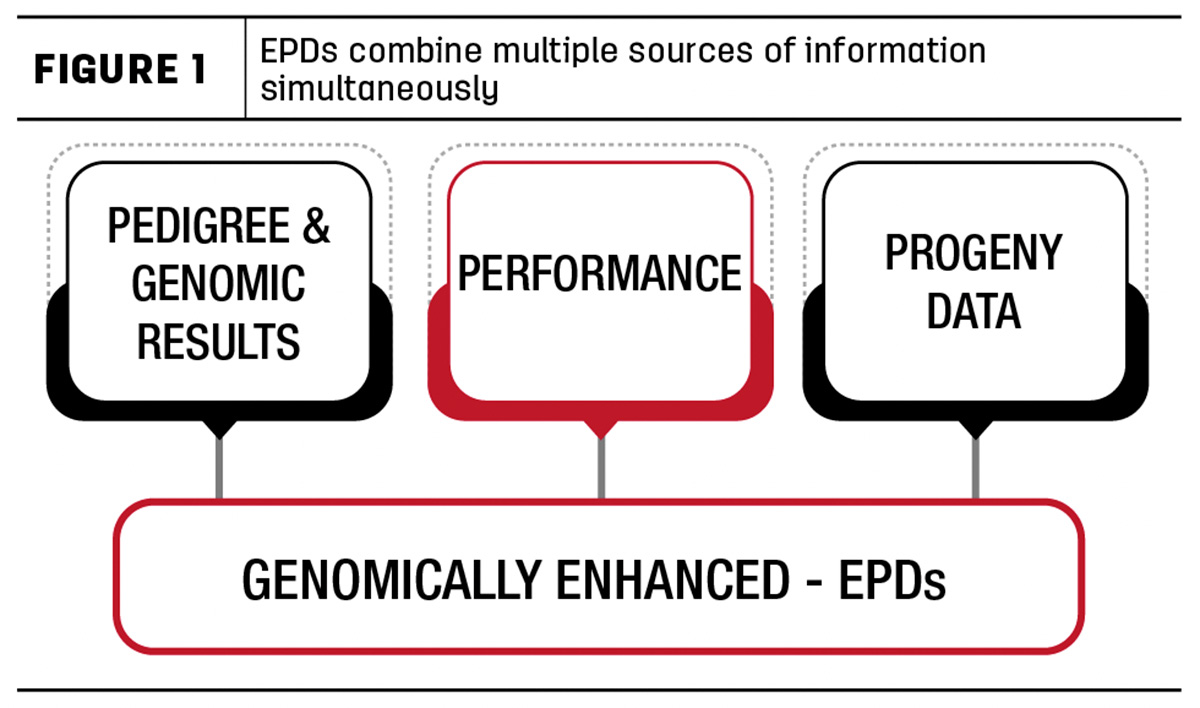Whether we are looking to purchase a new truck, determine how much hay will be needed for the winter or decide which NFL team is favored to win the Super Bowl, we use information to make those decisions. Oftentimes, the decisions are made based on information that spans many years and includes multiple facets to make the best decision. Selecting the next generation of cattle using tools such as expected progeny differences (EPDs) is no different.
The development of the selection tools available today provided by the American Angus Association (AAA), such as EPD and bioeconomic indexes ($ values) are made possible because of the investment producers make in recording pedigrees and collecting phenotypes, both performance and genomic data. Each piece of information that is used in the calculation of an EPD has a critical role in the value of the prediction, and it all starts with quality records.
The basis of genetic selection
Recording phenotypes is useful to improve prediction accuracy and decrease selection risk, and it all starts with quality data collection. It also provides the opportunity for producers to contribute their own data to their weekly evaluation versus relying on others to do so. With the inclusion of genomics in the evaluation, more precise pedigree relationships are used, which increases the accuracy of these genomically enhanced EPDs (GE-EPDs). Even with genomics included, phenotypic data is still vital, as it helps tie the genetics of an animal to the performance we see.
Breeders not only rely on the selection tools to be accurate and current, but their commercial customers do as well. Today, these tools can help market commercial calves to the feedlot because of commercial programs like the AAA’s Genetic Merit Scorecard, which aids in differentiating the value of Angus cattle against other cattle.
EPD basics
The best tool available today to help mitigate risk for genetic selection for the next generation of cattle is EPDs, specifically GE-EPDs. EPDs are used to predict how a particular animal’s progeny are expected to perform in the same environment compared to another animal’s progeny. EPDs are a tool designed to be used for cattle within the same breed. If comparing two animals – an Angus bull and a Hereford bull, for example – those EPDs are not directly comparable without using across-breed EPD adjustments provided by the U.S. Meat Animal Research Center (USMARC).
EPDs take into account multiple sources of information available, such as pedigree and genomic results, an animal’s own performance and performance of its progeny (Figure 1). While each one of these pieces can be used individually for selection, when combined in the EPD, they are far more accurate.

GE-EPDs
Genomically enhanced EPDs have been available for over a decade on registered cattle of multiple breeds that have been tested. What makes GE-EPDs a good tool to utilize when making selection decisions? They help mitigate risk. Advancements in technology, specifically genomics, have provided the opportunity to improve the accuracy of EPDs for a young, non-parent animal. Depending on the trait, GE-EPDs on unproven bulls have the same level of accuracy as if they already sired 10 to 36 calves; this is essentially equivalent to achieving the level of accuracy of an entire calf crop before the bull is ever turned out on females. The ability to make genetic selection decisions with less risk is an incredible opportunity for both commercial and purebred cattlemen.
Phenotypes are the foundation
While we are able to have this level of prediction accuracy on an animal at an early age, it doesn’t happen by chance. The backbone of the weekly National Cattle Evaluation (NCE) at the AAA are the phenotypes submitted by members (e.g., birthweights, weaning weights, yearling weights, scrotal circumference, pulmonary arterial pressures, carcass ultrasound records, carcass data, foot scores, docility scores, etc.). Because of producers’ dedication to phenotypic data collection, we have the opportunity to leverage genomic technology alongside the decades of phenotypes to make more-accurate predictions for young animals.
What is critical to maintain the level of selection tools we have today is the constant flow of new phenotypes into the NCE. Each generation further away an individual animal is from phenotypic records in the evaluation, the less useful those older records become. Without current, accurate phenotypes in the evaluation, genetic selection tools would lose prediction power. Phenotypes work hand in hand with genomics to make sure predictions on an unproven animal are as accurate as they can be. While some may think other members can submit the phenotypes and they will ride on their coattails by only doing genomic testing, in the long run, that is not beneficial for prediction accuracies. In fact, in many cases, simply relying on someone else’s phenotypes in a related pedigree to back your genotype will land many animals closer to breed average, especially for newer traits.
A world without phenotypes
With the addition of genomics, the question often arises: Why are phenotypes still needed? The team at Angus Genetics Inc. modeled what this could look like using carcass ultrasound scan records. The research suggests that if carcass ultrasound records ceased submission when genomic technology was added, we would see lower EPD accuracies on young animals and a lower rate of genetic improvement. Essentially, we increase the possibility of selecting the wrong bull. While there is a solid foundation in the NCE to make genetic predictions, it must continue to be fueled by current phenotypes to continue running properly.
Genetic selection has come a long way over the past several decades. While we are learning more and more every single day, what continues to hold true is the need for the ongoing measurement of quality, accurate phenotypes to allow genomic technology to continue making accurate predictions for animals at a younger age. Without those phenotypes to provide the basis for genomics, the world of genetic selection we know today would begin to look very different.








